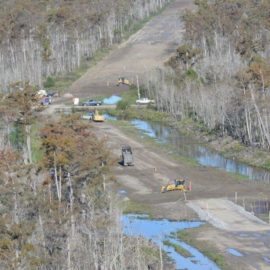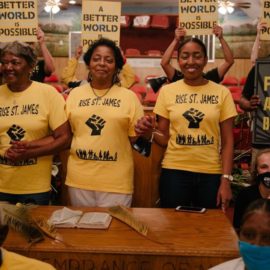
A desired Levee and a dirt pit. Not usually associated but in this case they are.
Local government officials and the owners of a large dirt pit in rural St. James Parish say they are close to settling a year-and-a-half long legal dispute over its operation and long-term management shortly before the pit could become a major source for a critical hurricane levee. But questions from residents and a lawsuit from a property owner could snag those plans. For more than a decade, the current and former owners of the Big Shake dirt pit in the Hester area have been positioning themselves to supply millions of cubic yards of high-grade clay to build the West Shore Levee now under construction in St. John the Baptist and St. Charles parishes. After thousands of homes in LaPlace flooded during Hurricane Isaac in 2012, the extension of the Lake Pontchartrain hurricane protection levee gained new momentum and long-missing federal funding amid outcry that the U.S. Army Corps of Engineers project, first authorized by Congress in the early 1970s, had lain fallow for decades. But homeowners living near the horseshoe-shaped Big Shake pit have objected to what they said was the recent restart of its operations and the pit owners’ hopes of being a supplier for the storm surge levee, potentially further boosting activity that was already occurring well before dawn each day behind their homes. The levee job for the then-unregulated pit would mean tens of thousands of trucks going past their homes and out on local highways, bringing noise and dusty air. The residents have contended the work would also eventually leave behind large, deep pits that would fill with water and erode, become home to snakes and gators in south Louisiana’s environment, and impede drainage routes that crisscross through the former sugar cane fields.
nola.com
On the one hand they bought there knowing the pit was there. On the other that amount of traffic is too much.
The dispute, which ended up in state district court in February 2021 and resulted in an eventual parish government stop-work order against the pit on June 9, underscores the many hurdles, often entirely unanticipated, that big federal flood protection projects can encounter. Parish officials have been trying to bring the grandfathered pit, which opened before the parish adopted a land use plan in the mid-2010s, under the new rules and regulate its operations and the plans for the left-over borrow pits. “That’s what brought us to court to start off with, because I needed to know what the end game was going to be for the community,” Parish President Pete Dufresne said. “I mean, this operation is surrounded by residents basically on all four sides of it. It’s not like it’s in the middle of a big vacant piece of land.” The new settlement attempts to find a middle path between neighbors’ concerns and Big Shake’s bid to supply the 18-mile levee extension, which is expected to cost $1.2 billion. Among the expected terms, parish officials said, the future pits, possibly as many as five, would become lakes for a new neighborhood that would be built around them. The final pits would have to be built to Corps of Engineers standards, including the slope of the pits’ banks, to reduce erosion of the area’s unstable alluvial topsoil. Residents in the Hester Heights neighborhood would get a 100-foot buffer of donated property, separating them from a borrow pit already dug near their homes, parish officials said.
The company is already working on betterments to the pits.
The company also has started to restore bank erosion from older, pre-existing pits that have eaten into a neighboring landowner’s property. The company is expected to agree to operational hours and put in a hard surface on a small portion of its internal network of earthen roads to cut down on dirt on La. 3125, a major thoroughfare in eastern St. James, parish officials said. With those and other basic outlines, the Parish Council has authorized Dufresne to sign the final deal. A copy wasn’t immediately available Friday, but Dufresne said a final version could be signed this week.
As with any decision, not all agree with the terms.
Officials with the pit owners, St. James Construction Materials, said they were pleased to be able to “work in partnership with Parish officials, residents and constituents to arrive at a mutually beneficial settlement. “The agreement will provide the necessary resources for flood protection for St. James Parish, create tax revenues for the future growth of the Parish and ensure the basis for future development consistent with the Parish’s land use ordinance,” company officials said in a statement. Not all is copacetic, however. Residents of Hester Heights say the buffer zone is far smaller than what would be required under a proposed ordinance for future pits that was triggered by the Big Shake dispute — 500 feet — or what other parishes require. They also worry that the parish wouldn’t be getting enough money from the owners in reserve if the pit owners don’t follow through on their promises. They also say the plan has not left clear who would be responsible for the lakes’ maintenance long-term. Dufresne said the lakes won’t be the parish’s maintenance responsibility. Laddie Roussel, the neighborhood’s developer and a resident, said the biggest concern, however, remains that officials “don’t have a clue what’s going to happen with flooding or drainage.” Drainage plans are expected to come later, not in advance, Roussel said. In defense of the deal, Dufresne said the prior parish administration allowed Big Shake to start operations without any controls and so his administration has been left to work out a compromise. Also, creating a 500-foot buffer in the Hester Heights area would likely mean Big Shake could no longer dig in the pit near those homes because the pit property is narrow in that area.
And, of course, someone has to sue some one else bring in the lawyers.
In addition to the residents’ concerns, the former farming family that once owned the Big Shake property has sued, in part, over the pending agreement. In July, Yolande Schexnayder and Sons Inc. and another plaintiff sued an affiliate company of St. James Construction Materials, alleging the pending settlement with the parish would reduce how much clay could be pulled from the ground. Under the land sale, Yolande Schexnayder was promised a cut of the clay sales for the West Shore Levee, as much as $12 million, as part of the payment for the property. The plaintiffs allege the settlement — along with earlier news that the Corps of Engineers would need about a third as much clay as originally anticipated — means the former owners of the pit property would get less than half of what they had originally been promised, the suit alleges. The plaintiffs have asked a state district judge to throw out the nearly three-year-old property sale and give the land back to Yolande Schexnayder and Sons.
This would not work to the parishes benefit.
If successful, the suit could leave the parish with a settlement with a company that no longer owns the pit. The litigation is in the early stages. In a statement, Yolande Schexnayder representatives said the company has not been invited or allowed to participate in the pit negotiations and so declined to comment directly on the “propriety, nature or effect of the purported settlement.” But they did say that the company does support “a negotiated settlement between St. James Parish Government and St. James Construction Materials that benefits St. James Parish and all of the stakeholders.” Because of the pit’s proximity to the levee, Big Shake has a potential price advantage.
Big Shake seems to have a lock on supplying the building material.
Court documents in the Schexnayder suit speak as if Big Shake was all but certain to supply the West Shore levee, but Corps officials said no decision on clay sources has been made yet. The selection of clay sources is made by the contractor eventually selected for that phase of levee construction. The contractor can bring in its own certified dirt sources or pick from a pre-approved Corps of Engineers list, said René Poche, a Corps spokesman in New Orleans. The federal agency also has stockpiled 1.5 million cubic yards of clay from the Bonnet Carré Spillway. Big Shake is on the pre-approved Corps list, as are others, but the levee construction contractor hasn’t been selected yet. Poche said the “first solicitation for (the West Shore) levees is going out mid-October.” Corps officials have said the levee project would not be impacted if Big Shake isn’t used.
There will be more to this story!



